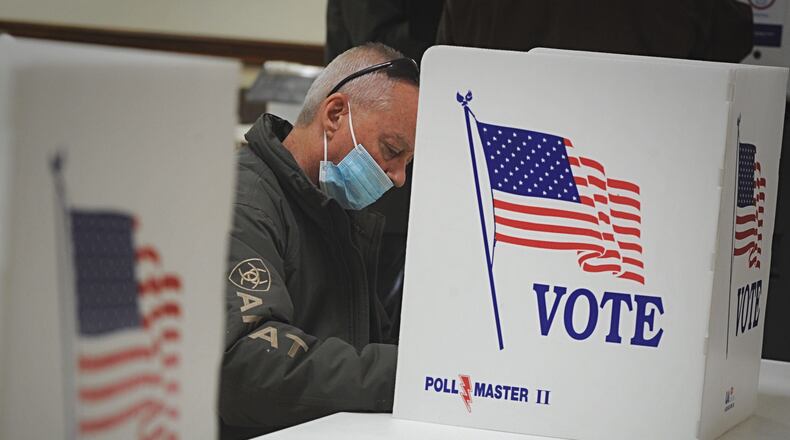For Ohio’s statewide offices and its open U.S. Senate seat, there is no confusion about boundaries or deadlines. Several of those offices have no partisan primary challengers — Democratic and Republican candidates for state treasurer, auditor and attorney general will only face each other in the Nov. 8 General Election, according to filings with Secretary of State Frank LaRose’s office.
Partisan primaries will be held on May 3 for governor and U.S. Senate, and a Republican primary for LaRose’s own seat.
Governor and lieutenant governor: Candidates for governor and lieutenant governor in the primary election include, on the Republican side, incumbents Gov. Mike DeWine and Lt. Gov. Jon Husted; former U.S. Rep. Jim Renacci and Joe Knopp; former state representatives Ron Hood and Candice Keller; and farmer Joe Blystone and Jeremiah Workman. Blystone’s previously announced running mate, Joanna Swallen, quit the campaign in September.
Democrats in the primary gubernatorial race are former Dayton Mayor Nan Whaley with running mate Cheryl Stephens, and former Cincinnati Mayor John Cranley with Teresa Fedor.
Secretary of State: Three Republicans and one Democrat are running. The Republicans are incumbent LaRose, John Adams and Terpsehore Maras-Lindeman. The Democratic candidate, who doesn’t face a primary challenger, is Chelsea Clark.
Ohio Treasurer: Candidates are incumbent Robert Sprague, a Republican; and Democrat Scott Schertzer, mayor of Marion.
Ohio Auditor: Candidates are Republican incumbent Keith Faber and Democrat Taylor Sappington, who is now auditor of Nelsonville.
Ohio Attorney General: Incumbent Dave Yost, a Republican, is seeking to retain his seat. He will face state Rep. Jeff Crossman, D-Parma, in November.
U.S. Senator: Eight Republicans and four Democrats are vying to replace U.S. Sen. Rob Portman, R-Ohio, who announced a year ago he would not seek a third term. A ninth, Cleveland businessman Bernie Moreno filed but on Feb. 3 withdrew from the race.
The Republican primary candidates are:
· Matt Dolan
· Mike Gibbons
· Bill Graham
· Josh Mandel
· Neil Patel
· Mark Pukita
· Jane Timken
· J.D. Vance
Democratic candidates are:
· Morgan Harper
· Traci Johnson
· Tim Ryan
· LaShondra Tinsley
The Ohio Redistricting Commission approved new maps for state House and Senate districts in September, but did so on a party-line vote. The Republican-authored plan would likely have maintained that party’s supermajority in both houses of the General Assembly.
Opponents of the maps sued, and on Jan. 12 the Ohio Supreme Court ruled 4-3 that the maps were gerrymandered to unfairly favor Republicans. The court gave commission members 10 days to draw new maps — which they did, approving another Republican plan in an identical party-line vote.
Opponents filed new objections and the court had not issued a new ruling as of Wednesday afternoon.
That left prospective candidates for state House and Senate seats in limbo, not knowing whether their district boundaries might change again or even if their district numbers would stay the same.
Though the filing deadline for Ohio House and Senate races has not moved, prospective candidates have some wiggle room in other areas. On Jan. 26 the General Assembly rushed through House Bill 93 to address some of the problems caused by continued litigation. Gov. DeWine signed it into law Jan. 28.
The new law eased requirements for candidates on gathering the required 50 signatures to run and will let candidates amend their applications if they need to move to run under new district lines.
LaRose sent a directive to all of the state’s 88 county boards of elections on Jan. 31 saying signatures on candidate petitions should be considered valid so long as both the now-overturned maps and the still-undecided maps included part of the signer’s county in the candidate’s district.
Signatures less than a year old, but given before new maps were approved, will also be considered valid, the directive says.
The law allows for leniency in other areas, said Rob Nichols, LaRose’s press secretary.
“House Bill 93 had a provision in it that said if you put the wrong district number on your filing, that’s not disqualifying because everything’s so fluid,” Nichols said.
Candidates will also have 30 days to move into the district they intend to run in, he said.
About the Author

